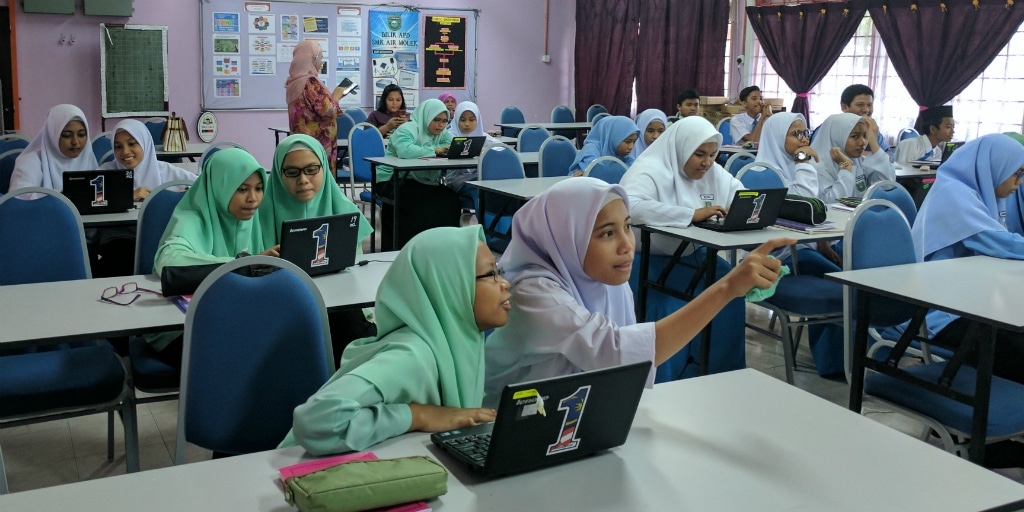EXECUTIVE SUMMARY
Over the past two decades, technology use in schools has surged worldwide. The open question remains, however, as to how exactly the rise in technology correlates with fundamental shifts in teaching, learning, and student outcomes.
Although this report touches on a number of school-based efforts to implement edtech, we focus on a particular use of technology: analyzing whether and how a sample of brick-and-mortar schools in three countries use online learning to deliver content in new, more flexible ways.
For the past decade, the Clayton Christensen Institute has studied how brick-and-mortar schools can effectively integrate technology to shift instruction to better differentiate to students’ needs—a shift that we call blended learning. Although technology can contribute to an array of school-based practices, online and blended learning programs represent one of the most profound opportunities to not merely arm students with devices or schools with WiFi, but to shift industrial-era instructional models that are ill-equipped to reach each and every student in a differentiated, customized manner. For this to occur, we need to track when and how technology integration efforts are or are not actually bringing about instructional model change.
Along with partners in Brazil, Malaysia, and South Africa, we distributed our online survey across samples of schools. We share and analyze data from 110 survey respondents in Brazil, 119 in Malaysia and 34 in South Africa, along with 13-15 case studies of specific school models.
The sampling methods that we drew from were at once too diverse and too constrained to each context to make broad conclusions in a consistent manner across these distinct geographies. Therefore, we do not intend for readers to directly compare the data sets among Brazil, Malaysia, and South Africa. Rather, each survey provides insights into some of the technology opportunities and challenges emerging in each country, specific to the sample of schools and educators we were able to reach through our survey partners. For future efforts to bolster the reach, reliability, and comparability of such surveys, we recommend how the survey instrument might be refined and deployed in a manner to make consistent, reliable regional, countrywide and inter-country conclusions about blended-learning implementation rates, opportunities and challenges.
Without directly comparing the samples, it is worth noting a few common themes that emerged across all three.
- First, the need to clearly distinguish between tech-rich versus blended-learning models arose across all three samples. In tech-rich models, technology may be present, but content is not being delivered online. Illuminating when technology is and is not being used to provide instruction could prove crucial to helping countries, states, schools, and vendors more deliberately leverage technology investments to shift instruction. Clarifying distinction between tech-rich and blended models might also begin to streamline and pool demand that could drive up the supply of edtech—particularly curriculum and content tools—that could begin to support more and diverse blended-learning models that align to national languages and curriculum.
- Second, innovations in online and blended learning tend grow differently in different circumstances, depending on the success metrics to which they are held. In at least two of the countries, namely South Africa and Malaysia, the degree of national centralization, of both curriculum and tools, clearly affects how blended learning stands to grow in particular geographies. Centralized models offer both upsides and downsides when considering how to spur and scale innovation generally, and blended learning in particular. Looking ahead, metrics driving technology integration will need to move beyond access to or usage of technology to measuring the learning outcomes technology integration efforts are aiming to produce.
- Third, infrastructure and human capital pose some of the greatest challenges to implementing technology in general, and blended learning in particular. Across all three surveys, connectivity, infrastructure, and educator professional development ranked among the greatest challenges reported to implementing technology in schools. These results suggest that connectivity and teacher support are major areas for countrywide investment to support blended-learning innovation. Absent major infrastructure overhauls or human capital investments, these findings also highlight the importance of not overstating education technology’s potential, absent the logistical and human factors that need to be in place to realize that potential.
We are witnessing the rise of technology-enabled instructional models that offer the chance to scale access to learning at a rate and manner historically out of reach. Tracking and analyzing if and how schools are making this shift is a crucial first step toward ensuring that rising investments in education technology are translating into greater access and success in learning.




